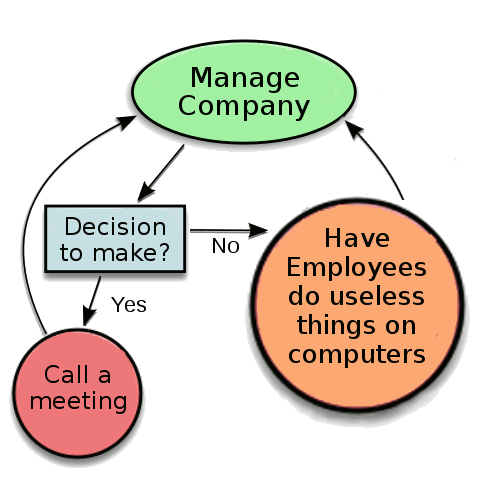Push Button Management
September 29, 2010
Having worked in
industrial research for thirty years, I've been subjected to a
plethora of
management initiatives, the names of which should be familiar to any reader of the
Dilbert comic strip. The problem with the management philosophies of the decade past is the "one size fits all" philosophy. They try to manage scientists the same way they manage assembly line workers. Although some scientists may work with rats in mazes, no scientist wants to be a rat in a maze. Insidious as management philosophy has been in the past, it's gotten worse with the ubiquity of computers. Corporate management now believes in the concept of "push button management" in which employees enter numbers into huge databases, and management decisions magically pop out. No need to think! Just look for the computer-generated
red flags and everything will be alright.

Flowchart of modern management.
Right from the start of computing, programmers realized that it wasn't just their algorithms that were important, it was also the quality of data that went into the algorithms. The catchphrase for this was, "
Garbage in, garbage out." We shouldn't forget the companion saying, "Whatever can go wrong will go wrong faster with computers." A lot of this
common sense has been forgotten, and managers routinely make decisions based on beautiful bar charts of data that are months out of date. As any
electrical engineer will tell you, putting a large
phase shift into a
feedback control system will result in wild
oscillations about the
setpoint.
The worse problem is that managers don't think about the physical realities behind the data. In the past, there were stories about the successful company president who started in the mail room and worked his way up the ranks. That's a guy who understood what the company actually does! This idea has even transcended generations to enter popular culture with the television series,
Undercover Boss. Most managers have little direct knowledge of the types of things their employees do. As a consequence, they can't develop a
model of how their company functions. They just react to the numbers.
And numbers they have in abundance!
Databases are now available that are large enough to encompass the operations of a large corporation in its entirety.[1] If the corporation does diverse things, such as making engines and athletic shoes, how do you compare
apples and oranges? You ignore the fact that they're apples and oranges, classify both as fruits, and just look at the numbers. More money for shoes this month, and less for engines. There's always a chart to justify the decision.

(illustration by Greg Williams).
Industrial scientists should be tasked with looking for the "next big thing." Unfortunately, that's hard to associate with a number. What's happened is that any project with a research horizon farther than a year or two is summarily dismissed. It's the incremental improvements that are funded, since they can be quantified as beneficial in the present management system. In a
previous article (The Two-by-Two Matrix, September 1, 2010), I quoted French President,
Nicolas Sarkozy, who was addressing the
International Conference on High Energy Physics (
Paris, 2010):
"Without basic research, there can be no applications... After all, electricity and the light bulb were not invented by incremental improvements to the candle." [2]
Corporations argue that it's the job of universities and government labs to do this long-range and basic research. Universities, however, don't have the specialized and industrial-scale facilities required for much of this research. The work of government laboratories, while valuable, offers no competitive advantage, since it's available to all on a level playing field. There's the further problem of research direction. Are these outsiders engaging in the research most valuable to your company?
A book published by
Bell Labs during its heyday was entitled, "Mission Communications: The Story of Bell Laboratories."[3] The idea was that Bell Labs had a mission, to advance communications technology, and it was relentless in pursuit of that mission, arguably to very good result. Corporations should again adopt this mission strategy, set their scientists free to pursue research directed in their mission areas, and get themselves back onto a course that earns profit through
innovation, not cost-cutting.
References:
- Two examples are SAP and Oracle.
- Lauren Schenkman, "Random Samples," Science, vol 329, no. 5992 (August 6, 2010), p. 613.
- Prescott C. Mabon, "Mission Communications: The Story of Bell Laboratories," Bell Telephone Laboratories, Incorporated (Murray Hill, NJ, 1975)
Permanent Link to this article
Linked Keywords: Industrial research; plethora; management initiative; Dilbert; red flags; Garbage in, garbage out; common sense; electrical engineer; phase shift; feedback control; oscillations; setpoint; Undercover Boss; model; Databases; apples and oranges; Nicolas Sarkozy; International Conference on High Energy Physics; Paris; Bell Labs; innovation; SAP; Oracle.